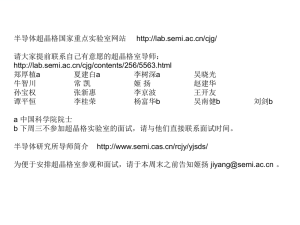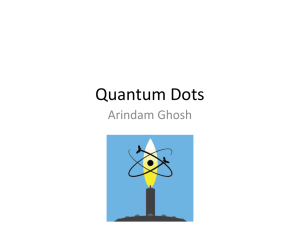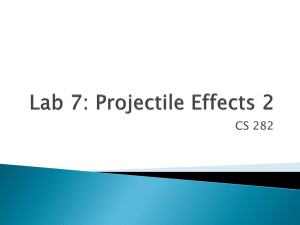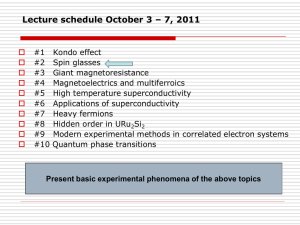Spintronics:NewTendency in Electronics
advertisement
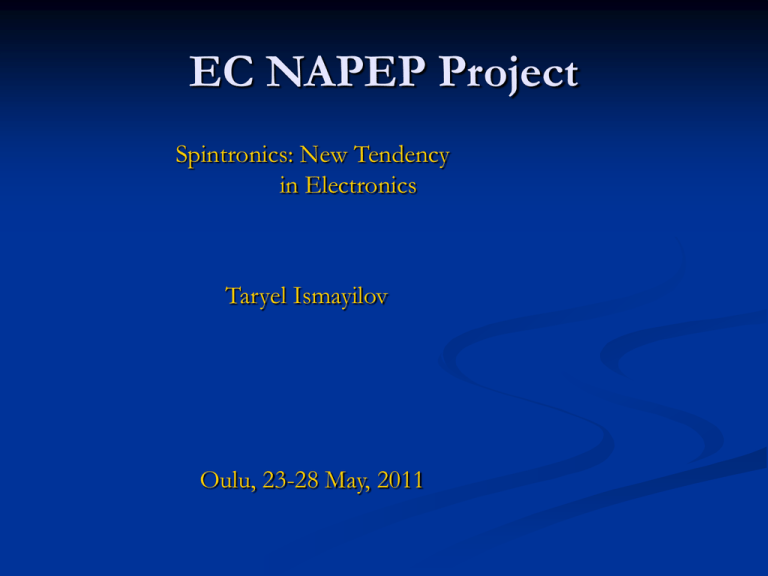
EC NAPEP Project Spintronics: New Tendency in Electronics Taryel Ismayilov Oulu, 23-28 May, 2011 Spintronics: New Tendency in Electronics • Introduction • Size quantization • Spin-orbit interaction in semiconductors • Spin-Hall Effect (SHE) • Spin Dipole • Detection of spin current: a nano-mechanical proposal • Detection of spin current: by inverse SHE • Spin injection • Spin-orbit interaction at metal alloy surfaces • Summary Semiconductor Electronics Spintronics for the 21st Century Conventional Electronics Charge Based on number of charges and their energy Performance limited in speed and dissipation Spintronics Spin Based on direction of spin and spin coupling Capable of much higher speed at very low power In March of 1959, Richard Feynman challenged his listeners to build “Computers with wires no wider than 100 atoms, a microscope that could view individual atoms, machines that could manipulate atoms 1 by 1, and circuits involving quantized energy levels or the interactions of quantized spins.” Richard Feynman - “There’s Plenty of Room at the Bottom”, 1959 Annual Meeting of the American Physical Society Quantum computing Classical Bit (Boolean) 0 or 1 Two states Quantum Bit (Qubit) α|0>+ β|1> Infinite number of states” Where Size Quantization Size Quantization Frohlich (1937), I.M Lifshitz (1951, 1952) R.Kubo (1962) V.Sandomirskii (1962) DOS in Low-Dimensional Electron Systems Spherical Quantum Dot Two-Dimensional Electron Systems Low-Dimensional Electron Systems Electron An electron has a charge (- e) and a spin (½) -e (spin) + -e (charge) Electronic industries have made good use of the charge But the electron spin has essentially been neglected Application of spin current Electric current -> electronics Spin current -> spintronics What is the spin current? Electrons carry both charge and spin which may have two components: up and down. j j The electric current J c e j j 0 If the currents of electrons for different spins are not equal, The spin current Js j j 0 2 From the abstract of “Spintronics: Fundamentals and applications” : “Spintronics, or spin electronics, involves the study of active control and manipulation of spin degrees of freedom in solid-state systems” Reviews of Modern Physics, vol. 76, p.323-410, 2004, by I. Žutić, J. Fabian, and S. Das Sarma • • • • Spintronics where magnetic material and magnetic field is involved: GMR: giant magnetoresistive effect Memory / storage TMR, CMR Spin-based Quantum Computing: uses spin of nuclei as qubits • All electrical means of generation and manipulation of spins: spin-polarized transport in semiconductors spin FET, spin filter, logic / storage The spin-orbit interaction is a relativistic correction to the non-relativistic Pauli equation, which arises as a combination of two effects: (i) the effective magnetic field experienced in its rest frame by an electron moving in an electric field and (ii) the Thomas precession of the rest frame of an accelerated electron. It is derived from the Dirac equation and expressed as Here m is the free electron mass, P is the momentum operator, e is the electronic charge, σ =(σx , σy , σz) is the vector of Pauli matrices, V(r) is the potential energy and ∇ stands for spatial gradient. The Dirac equation describes a relativistic particle: Expansion of this equation in yields the single-particle Schredinger equation, plus some spin-dependent terms The last term on the right hand side couples the spin to the momentum in the presence of an electric field, hence the name “spin-orbit coupling” This effect is small in free space, but can be rather large in semiconductors Spin-orbit coupling in semiconductors In a semiconductor heterostructures the spin-orbit Hamiltonian is usually described by the Rashba form: where α is proportional to the electric field, which is perpendicular to the 2D electron gas formed in semiconductor heterostructures. The spin-Hall effect It turns out that the RashbaHamiltonian gives rise to a pure transverse spin current in response to a charge current 2DEG The associated spin-Hall conductivity has a universal value in the 2D plane, and is of much interest to the spintronics community. How does this effect manifest itself in quasi - 1D quantum wires? The spin-Hall effect –1D calculations Assume a quantum wire with confinement along the x-axis and ballistic transport along the y-axis: Also assume hard-wall boundary conditions along x With an electric field along the z-axis,the Schrodinger equation becomes Write the wave function as Tranzistors Spin transistor: Datta and Das (1990) Working principe SFET Physical origin of this large enhancement in the SO coupling constant: • a brief review of how SOI comes about, starting from the Dirac equation. • how does the SOI coupling constant gets enhanced in semiconductors: •k p approach. From micro to nanoelectronics The characteristic size of an element of 30 nanometers or less Density more than 108 transistors on 1 sq. cm for logic Density more than 1010 bits on 1 sq. cm for memory The price less than 50 microcents for the transistor for logic The price less than 660 nanocents for memory bit Frequency of switching of 10 GHz Low power consumption: 1.4 billion transistors of the processor use less than 170 Watt In 2005 for every second in the world it was made more than 2 billion transistors The forecast for 2012 Spin-orbit coupling in semiconductors Hamiltonian, describing this interaction, as it is known, is from expansion of the of Dirac equation to within members of an order and looks like: Hamiltonian of Rashba describes spin-orbital interaction in an asymmetrical potential hole (Rashba 1960) Dresselhaus Hamiltonian is received for 3D semiconductor crystals without the inversion centre (Дрессельхаус1955) Spin-orbit coupling in semiconductors Spin-orbit coupling in semiconductors (Rashba 1960) Spin-orbit coupling in semiconductors Rashba-Dresselhaus I. The Researches executed recently, have shown that the spin Hall effect opens new possibilities in management of electronic polarisation and transport in nonmagnetic semiconductors for lack of a magnetic field. II. Interest to this problem is connected not only with possible applications in the information industry (for processing and information storage), but also with statement of new problems in the physics of the condensed matter. Magnification of volumes and transfer velocity of information comes nearer to a limit related with the basic physical restrictions on the further reduction of the sizes of active elements of devices. For electronics development it is necessary search of new solutions and principles. The most perspective from directions "Spintronika". It is new field of a science and technicians, in which not only a charge, but also a spin of electron is used for storage and transmission of information. Spintronics history 1988 - Giant Magnetoresistive Effect (GME) discovered by Albert Fert and Peter Gruenberg. 1989 - IBM scientists made a string of key discoveries about the “GMR" effect in thin-film structures. 1997 - first GMR (Giant magnetoresistive) Harddisk head introduced by IBM. 2000 - University of Buffalo get 10$ million to develop specific ferromagnetic materials for use in "spintronics 2001 - University of Arkansas physicists have successfully injected a stream of electrons with identical spins into a semiconductor. 2002 - A new device allows the polarization of an electron to determine the switching of the device 2002 - Plastic Shows Promise For Spintronics, Magnetic Computer Memory 2003 - M Ouyang and D Awschalom of the University of California at Santa Barbara have transferred electron spins across molecular ‘bridges’ between quantum dots for the first time. 2004 The Korea Institute of Science and Technology (KIST) and MIT's Francis Bitter Magnet Laboratory have launched a 10-year program in spintronics. IBM scientists view a single electron spin with a special atomic force microscope 2005 New Spintronic Speed Record - 2GHz MRAM devised. 2006 January - Researchers at the University of Michigan created a computer chip based on the esoteric science of quantum mechanics. July - Freescale begins selling 4-Mbit MRAM. September - Spin Hall effect detected at room temperature. 2007 February - New European Initiative To Develop Spintonics Computing Devices April - University of Delaware receives $1.9 million for new spintronics center Furdyna JAP 1988 Heterostructure: Two-Dimensional System Spin Hall effect. Mechanism. (Sinova, et al, 2004) In presence of electric field Ex , when Fermi distribution of electrons is shifted along px , electron spins with py>0 are turned up, but electron spins with py<0 are turned down. How to produce a non-equilibrium spin population Injection from a ferromagnet to a normal metal or semiconductor, through an interface; via electrical currents, or optical excitation. Creation of electron-hole pairs by circularly polarized light above the band gap of semiconductor. Electrical transport through a quantum dot in an applied magnetic field Use of electrical currents to generate spin currents and polarization without magnetic fields or ferromagnets, via spin-orbit coupling. Reference Spin Physics in Semiconductors Editor: M.I. Dyakonov, Springer Series in Solid State Sciences, Springer-Verlag Berlin Heidelberg, 2008 S. Murakami, N.Nagaosa, S.C. Zhang, Science 301, 1348 (2003), Phys. Rev. B 69, 235206 (2004) J. Sinova et al., Phys. Rev. Lett. 92, 126603 (2004) J. Wunderlich et al, Phys. Rev. Lett. 94, 047204 (2005) Y.K. Kato et al., Science 306, 1910 (2004) Shih et al. Naturephysics, October (2005) Э. Рашба, ФТТ, 2,1224 (1960) G. Dresselhaus, Phys. Rev. 100, 580 (1955) M.I. Dyakonov, V.I. Perel, Phys. Lett. 35A, 459 (1971) J.E. Hirsch, Phys. Rev. Lett. 83, 1834(1999) S.-Q. Shen, Phys. Rev. B 70, 081311(R)(2004) S.-Q. Sheng, Phys. Rev. B 70, 081311(R) (2004) E.G. Mishenko, A.V. Shytov, and B.I. GalperinPhys. Rev. Lett. 93, 226602 (2004) J. Schliemann, D. Loss, Phys. Rev. B 69, 165315 (2004). SPINTRONICS: PYSICAL BASIS AND APPLICATIONS • D.D. Awshalom, D.Loss, N.Samarth, Semiconductor spintronics and quantum computing. Springer. • S.D. Ganichev, W. Prettl, Spin photocurrents in quantum wells. 2003 • T. Jungwirth, J. Sinova, J.Masek, J. Kuchera, A.H.MacDonald Theory of ferromagnetic (III, Mn)V semiconductors. 2006 • Ohno H. Toward Functional Spintronics. 2001. • Žutić I., Fabian О., Das Sarma S. Spintronics: Fundamentals and applications.2004. • Захарченя Б.П., Коренев В.Л. Интегрируя магнетизм в полупроводниковую электронику. // УФН. 2005. • C. Timm, Disorder effects in dilute magnetic semiconductors, 2003 • T. Dietl, Ferromagnetic semiconductors • Bibes, Bartolomey, Oxide spintronics, cond mat 2007 • B.A. Aronzon, S.V. Kapelnitsky and A.S. Lagutin, Transport and Magnetic Properties of Nanogranular Magnetic Metals, Elsiever 2007 Научиться воздействовать на спин, как на заряд, током, магнитным полем, светом. Переход от малой области (магнитный домен) к отдельному спину Thank you for attention!






